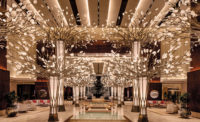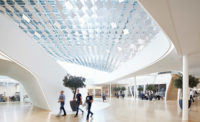Subtlety is a surprising quality to find in a sculpted head similar in size to those on Mount Rushmore, but that is the impression achieved by Boston-based artist Ralph Helmick in a new Abu Dhabi monument to Sheikh Zayed bin Sultan Al Nahyan, the late emir and first president of the United Arab Emirates (UAE). Formed of 1,327 football-sized geometric solids suspended on 1,110 cables in a 100-foot-high open-sided triangular prism, the disaggregated portrait “employs a kind of ‘active perception,’ where we as viewers help to create the image,” says the artist. To view it, visitors enter a tranquil eight-acre public garden planted with desert trees and grasses, leaving behind the bustle of the beachfront Corniche Road. Walkways that ring the pavilion provide vantage points from which the abstract assembly resolves into Zayed’s familiar features. For the full effect, however, viewers must wait until dusk, when electric lighting makes the stainless-steel polyhedrons shine like stars, giving the artwork its title, The Constellation.
Additional Content:
Jump to credits & specifications
“It looks simple, but the design process wasn’t,” says David McNeil, director of dpa lighting consultants, who spent six years working on the scheme. The challenge was to cast the desired amount of light on each of the Platonic solids without illuminating other parts of the structure or surrounding area, and to do so while concealing the source. “As architectural-lighting consultants, we want people to see what we’re lighting, not the lighting itself,” says McNeil.
Design development proceeded primarily through physical models because “computer simulation wouldn’t show us the richness or depth of the lighting,” says McNeil. As the project progressed, Helmick built a 1:10 scale mock-up, and the dpa team traveled from the firm’s Dubai office to Boston to test hundreds of fixtures. Washes and floodlighting were ruled out, as they offered too little control and lent a “flat” quality to the work. Instead, using a large number of narrow-beam point-source fixtures to illuminate the solids individually was “the right way to go,” says McNeil. “We wanted them to sparkle and could only achieve that with narrow-beam fixtures.”
It was also important that the luminaires provide a warm color temperature of 2700 Kelvin, dpa having decided that cooler whites appeared “too clinical,” and be small, with an adjustable aim. “We knew that we’d have to do extensive on-site commissioning, spending a lot of evenings molding the image with light to pick up the details of the face,” says McNeil. Since no off-the-shelf lighting system met all of these criteria, a custom fixture was developed by Lumascape, in two slightly different variations.
From the triangular plinth of the pavilion, 1,203 uplights illuminate the solids from below. They are buried up to the aperture in sandstone gravel. Another 782 luminaires are installed in the canopy, positioned to finish flush with the steel soffit. Each fixture is fitted with a 3.5-watt LED and integral DMX control to allow variations in the intensity of light. Their warm, white hue lends a soft golden glow to the jewel-like stainless-steel solids, which have a matte finish to minimize unwanted reflections.
The location of the cables precluded regular grid arrangements for the fixtures, so their positioning “is tailored to where the focus should be,” says McNeil. “Denser parts are concentrated around the features of the face, and there’s less lighting where his headdress tails off at the back.”
As the monument is little affected by light pollution, dpa could “get away with very low light levels,” says McNeil. “The park is supposed to be a quiet, relaxing space, so we wanted to bring the levels down as much as possible without losing the intensity.” The brightest of three programmed “scenes” fades up about 10 minutes before the sun drops below the horizon. The light dims as the evening darkens and again after midnight, when the park is closed to visitors, to save energy.
Such restraint, and the designers’ success in disguising the effort behind the effect, lends a sense of serene simplicity to the work, a fitting finish to a presidential portrait that seeks to evoke affection, not awe.
CreditsArtist: Ralph Helmick
Architect of record: Meticulous Design + Architecture
Lighting designer: dpa lighting consultants — Barry Hannaford, David McNeil, Lee Sweetman, directors
Engineer: Meinhardt Group
Fabricator: Stage One
Consultant: Estidama (energy code compliance)
|
SpecificationsLighting Lumascape |





